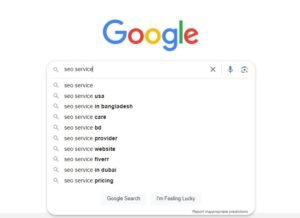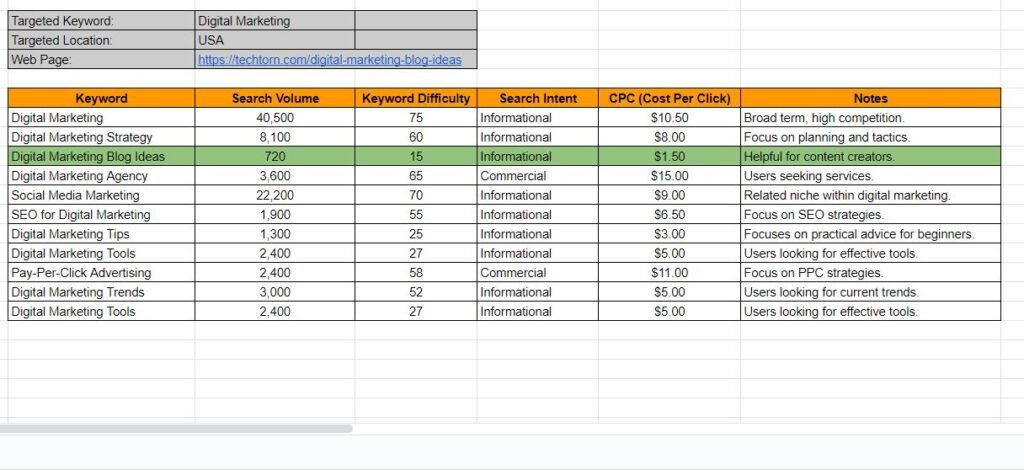Keyword research for the USA
Keyword research for USA involves identifying the specific terms and phrases potential customers use to search for products or services. First, technical professionals should utilize various tools, such as Google Keyword Planner or SEMrush, to discover relevant keywords. Next, analyze search volume, competition, and trends to prioritize which keywords to target. Incorporating long-tail keywords can be beneficial, as they often have lower competition and higher conversion rates. Additionally, understanding user intent behind keywords helps create content that aligns with what users are looking for. Ultimately, effective keyword research lays the foundation for successful SEO strategies, enabling businesses to enhance their visibility in search engine results and attract the right audience.
keyword research may also be called: keyword analysis, keyword discovery, keyword identification, search term analysis, keyword exploration, keyword investigation, keyword strategy development, search query analysis, and phrase research.
Elements of Keyword Research
- Seed Keywords
- Search Volume
- Keyword Difficulty
- Search Intent
- Long-Tail Keywords
- Competitive Analysis
- Trends and Seasonality
- Geographic Targeting
- Related Keywords
- Content Gap Analysis
- SERP Features
- User Questions
- Click-Through Rate (CTR) Potential
- Cost-Per-Click (CPC)
- Keyword Variations
Keyword research composed of the following components:
- Keyword Identification
- Search Volume Analysis
- Keyword Difficulty Assessment
- Competitor Keyword Analysis
- User Intent Exploration
- Long-Tail Keyword Research
- Trends and Seasonality Evaluation
- Geographical Targeting Consideration
- Search Intent Classification
- Content Gap Analysis
How to Identify Keywords
- Brainstorm ideas
- Use keyword research tools
- Analyze competitor keywords
- Consider search intent
- Focus on long-tail keywords
- Check search volume
- Evaluate competition
- Use Google suggestions
- Review related searches
- Refine your list
How to Analyze Competitors in SEO
Analyzing competitors is crucial for developing effective SEO strategies. Start by identifying your main competitors, focusing on those targeting the same audience and keywords. Use tools like SEMrush or Ahrefs to discover their top-performing keywords. For instance, if your target keyword is “digital marketing,” check which variations they rank for and their search volume.
Next, evaluate their content quality. Look for blog posts, infographics, and videos. Assess the engagement they receive, such as shares and comments. Additionally, examine their backlinks. Tools can show you where their links come from, helping you identify potential outreach opportunities.
Finally, monitor their social media presence. Analyze their follower engagement and post frequency. This holistic view enables you to refine your strategies and stay competitive.
Step | Action |
Identify Competitors | List competitors targeting similar keywords |
Keyword Research | Use tools to find their top keywords |
Content Evaluation | Review the quality and engagement of their content |
Backlink Analysis | Check sources of their backlinks |
Social Media Monitoring | Analyze engagement and posting frequency |
Tools for Keyword Research
- Google Keyword Planner
- SEMrush
- Ahrefs
- Moz Keyword Explorer
- Ubersuggest
- AnswerThePublic
- Keyword Tool
- Soovle
- Google Trends
- SpyFu
- Keyword Surfer
- Long Tail Pro
- KWFinder
- Bing Keyword Research Tool
- Wordtracker
To enhance performance, try using the keyword discovery tool.
Search Intent of Keyword Research
- Informational Intent
Users seek knowledge or answers to specific questions. - Navigational Intent
Users look for a particular website or page. - Transactional Intent
Users intend to make a purchase or complete a transaction. - Commercial Investigation Intent
Users are researching products or services before buying. - Local Intent
Users want information about businesses or services in a specific location. - Problem-Solving Intent
Users are searching for solutions to specific problems or challenges. - Comparative Intent
Users seek to compare options, products, or services before making a decision.
Researching Keywords from Google Suggested Keywords
Keyword research is essential for effective SEO and can be done easily using Google’s suggested keywords. Here’s a straightforward approach:

- Start with a Base Keyword: Begin by entering your primary keyword into Google’s search bar. For instance, using “digital marketing”.
- Analyze Suggested Searches: Look at the drop-down suggestions that appear as you type. These suggestions reflect popular searches related to your base keyword.
- Check Related Searches: After performing the search, scroll to the bottom of the results page. Here, you’ll find “related searches,” which can provide additional keyword ideas.
- Use Keyword Tools: Supplement your findings with tools like Google Keyword Planner or Ubersuggest for more detailed data.
Keyword Research Using “People Also Search For”

- Start with a Seed Keyword
- Perform a Search
- Analyze Related Keywords
- Expand Your List
- Assess Search Intent
Keyword Research Table Structure
Keyword | Search Volume | Keyword Difficulty | Search Intent | CPC | Notes |
Example Keyword 1 | 1,200 | Medium | Informational | $2.50 | High relevance, consider using |
Example Keyword 2 | 800 | Low | Commercial | $1.80 | Good opportunity |
Example Keyword 3 | 5,000 | High | Navigational | $3.00 | Highly competitive |
Example Keyword 4 | 300 | Low | Informational | $0.90 | Low competition |
Example Keyword 5 | 1,500 | Medium | Transactional | $4.20 | Target for paid campaigns |
How to Choose a Focusing Keyword
- Analyze Search Volume: Look for keywords with a significant number of searches. A higher search volume indicates greater interest.
- Assess Competition: Check the level of competition for each keyword. Aim for keywords that have moderate competition; this gives you a better chance of ranking.
- Evaluate Relevance: Ensure the keyword aligns with your content. It should be relevant to the topic you plan to write about.
- Consider Intent: Understand the search intent behind the keyword. Is the user looking for information, or are they ready to buy? Choose a keyword that matches the intent.

Optimizing your content around a focusing keyword is essential for effective SEO. By following these optimization steps, you can improve your chances of ranking higher in search results, ultimately attracting more traffic.




